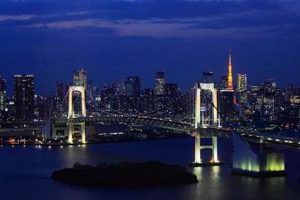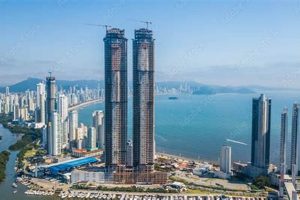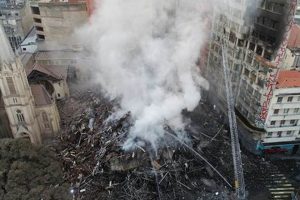Cross skyscraper reflections occur when sunlight reflects off the glass facades of skyscrapers, creating a dazzling display of light and color that can be seen from miles away. Reflections from adjacent buildings create a dynamic interplay of light and shadow, resulting in ever-changing patterns that captivate the eye.
This phenomenon not only enhances the visual appeal of urban landscapes but also provides valuable insights into the architectural design and urban planning of a city. The intensity and angles of reflection can reveal the orientation and curvature of buildings, highlighting their unique features and interactions with the surrounding environment. Architects and urban planners utilize these reflections as a tool to understand how buildings interact with natural light and to create more sustainable and aesthetically pleasing urban environments.
Cross skyscraper reflections have also become an integral part of contemporary urban photography, with photographers capturing the interplay of light and architecture to create stunning and surreal images. These reflections serve as a testament to the transformative power of sunlight and the ever-changing nature of urban landscapes.
1. Architectural interplay
Cross skyscraper reflections are a manifestation of the architectural interplay between buildings. The reflective surfaces of skyscrapers act as mirrors, capturing and reflecting the light that falls upon them. This reflected light reveals the design and orientation of adjacent buildings, creating a captivating visual dialogue. The angles, curves, and patterns of these reflections showcase the unique characteristics of each building, highlighting their relationship to one another and to the urban fabric.
Understanding the architectural interplay revealed through cross skyscraper reflections is crucial for architects and urban planners. By analyzing these reflections, they can gain insights into how buildings interact with their surroundings and how they contribute to the overall aesthetic of the city. This understanding can inform design decisions, ensuring that new buildings complement the existing urban environment and create a harmonious and visually appealing cityscape.
For instance, the reflections of the Gherkin building in London reveal its distinctive elliptical shape and its relationship to the surrounding rectangular structures. Similarly, the reflections of the Burj Khalifa in Dubai showcase its towering height and its dominance over the city’s skyline. These reflections not only enhance the visual appeal of these buildings but also provide valuable information about their design and orientation.
In conclusion, the architectural interplay revealed through cross skyscraper reflections is a vital aspect of urban design. By understanding and harnessing this interplay, architects and urban planners can create more visually engaging and cohesive urban environments.
2. Urban planning
Cross skyscraper reflections offer valuable insights into urban planning, revealing how buildings interact with their surroundings and how they contribute to the overall character of a city. By analyzing these reflections, urban planners can gain a deeper understanding of the relationships between buildings, open spaces, and the urban fabric. This understanding can inform planning decisions, ensuring that new developments complement the existing urban environment and create a more sustainable and livable city.
For instance, cross skyscraper reflections can reveal how buildings affect the flow of pedestrian traffic and the distribution of sunlight in public spaces. This information can be used to design streets and plazas that are more inviting and comfortable for pedestrians. Additionally, reflections can provide insights into the energy efficiency of buildings, as they can reveal how buildings interact with sunlight and how they cast shadows on adjacent buildings. This information can be used to design buildings that are more energy-efficient and reduce the urban heat island effect.
In conclusion, cross skyscraper reflections are a valuable tool for urban planners, as they provide insights into how buildings interact with their surroundings. By understanding and harnessing these reflections, urban planners can create more sustainable, livable, and visually appealing cities.
3. Light and shadow
Cross skyscraper reflections are a manifestation of the dynamic interplay of light and shadow in urban environments. The reflective surfaces of skyscrapers act as mirrors, capturing and reflecting the light that falls upon them, creating a dazzling display of light and shadow. This interplay transforms the visual appeal of cities, adding depth and dimension to the urban landscape.
The angles, curves, and patterns of cross skyscraper reflections create a constantly changing visual spectacle. As the sun moves across the sky, the reflections shift and dance, creating a mesmerizing effect. This interplay of light and shadow can be particularly striking at sunrise and sunset, when the warm hues of the sky cast a golden glow on the buildings and their reflections.
The interplay of light and shadow also affects the way we perceive the scale and mass of buildings. Reflections can make buildings appear taller, wider, or more imposing, depending on the angle of the light and the surrounding environment. This effect can be used to create a variety of visual effects, from the awe-inspiring to the surreal.
In addition to their aesthetic appeal, cross skyscraper reflections can also provide insights into the design and construction of buildings. By analyzing the way light reflects off a building, architects and engineers can gain a better understanding of the building’s form and structure. This information can be used to improve the design of future buildings and to ensure that they are visually appealing and structurally sound.
In conclusion, the interplay of light and shadow in cross skyscraper reflections is a key aspect of urban design. By understanding and harnessing this interplay, architects and urban planners can create more visually engaging and dynamic urban environments.
4. Sustainability
Cross skyscraper reflections play a crucial role in sustainable design, as they provide valuable insights into how buildings interact with natural light. By analyzing these reflections, architects can design buildings that are more ene
rgy-efficient, reduce the urban heat island effect, and create more comfortable and healthy indoor environments.
- Energy efficiency: Cross skyscraper reflections can reveal how buildings interact with sunlight, providing insights into how to design buildings that are more energy-efficient. For instance, by analyzing the way light reflects off a building, architects can determine the optimal placement of windows and shading devices to maximize natural light and reduce the need for artificial lighting.
- Urban heat island effect: Cross skyscraper reflections can also help to reduce the urban heat island effect, which is the phenomenon where cities are significantly warmer than their surrounding rural areas. By understanding how buildings reflect and absorb sunlight, architects can design buildings that minimize heat gain and contribute to a cooler urban environment.
- Indoor environment: Cross skyscraper reflections can also affect the indoor environment of buildings. By analyzing the way light reflects off a building, architects can design buildings that provide occupants with more natural light and views, which can improve occupant well-being and productivity.
- Materiality and Facade Design: Cross skyscraper reflections can also influence the choice of building materials and facade design. By understanding how different materials reflect and absorb light, architects can select materials that minimize glare and heat gain, contributing to a more comfortable and sustainable indoor environment.
In conclusion, cross skyscraper reflections are a valuable tool for architects seeking to design more sustainable buildings. By understanding and harnessing these reflections, architects can create buildings that are more energy-efficient, reduce the urban heat island effect, and create more comfortable and healthy indoor environments.
5. Urban photography
Cross skyscraper reflections are a captivating subject for urban photographers, as they offer a unique perspective on the built environment and the interplay of light and shadow within cities. Photographers harness the reflective surfaces of skyscrapers to capture stunning images that showcase the architectural beauty and dynamism of urban landscapes.
These reflections can transform ordinary buildings into extraordinary works of art, revealing hidden details and patterns that are often missed by the naked eye. By capturing these reflections, urban photographers not only document the physical form of the city but also its intangible qualities, such as its energy, movement, and atmosphere.
Moreover, cross skyscraper reflections provide valuable insights into the urban environment. They can reveal the relationships between buildings, open spaces, and the urban fabric, highlighting the ways in which the built environment shapes our experience of the city. By understanding and harnessing these reflections, urban photographers can create images that not only capture the beauty of cities but also provoke thought and inspire dialogue about urban design and planning.
In conclusion, the connection between urban photography and cross skyscraper reflections is a mutually beneficial one. Urban photographers rely on these reflections to create stunning images that capture the unique character of cities, while cross skyscraper reflections provide valuable insights into the built environment and its impact on our lives.
6. Artistic inspiration
Cross skyscraper reflections have served as a rich source of inspiration for artists and designers across various creative fields, including architecture, painting, photography, and filmmaking. These reflections offer unique and captivating perspectives on the built environment, inspiring creative minds to explore new forms, patterns, and compositions.
One of the key reasons why cross skyscraper reflections are so inspiring is their inherent beauty and complexity. The interplay of light and shadow, the geometric patterns created by the reflections, and the ever-changing nature of these reflections provide endless possibilities for artistic exploration. Artists have harnessed these reflections to create stunning works of art that capture the dynamic and ever-evolving nature of urban landscapes.
For instance, the American artist Edward Hopper was fascinated by the cross skyscraper reflections in New York City. He incorporated these reflections into many of his paintings, such as “Nighthawks” (1942) and “Early Sunday Morning” (1930). Hopper’s use of reflections adds a sense of depth and mystery to his paintings, inviting viewers to contemplate the relationship between the built environment and the human experience.
Cross skyscraper reflections have also influenced the field of architecture. Architects have studied these reflections to understand how light interacts with buildings and how this can be used to create more visually appealing and sustainable buildings. For example, the architect Frank Gehry was inspired by the cross skyscraper reflections in Los Angeles when designing the Walt Disney Concert Hall. The building’s curved facade is designed to reflect the surrounding buildings and the sky, creating a visually stunning and iconic landmark.
In conclusion, the connection between cross skyscraper reflections and artistic inspiration is a mutually beneficial one. Cross skyscraper reflections provide artists and designers with a rich source of inspiration, while artists and designers use their creativity to interpret and express the beauty and complexity of these reflections. This interplay between art and architecture leads to a deeper understanding and appreciation of the built environment and its impact on our lives.
7. Cultural significance
Cross skyscraper reflections have become a cultural symbol, representing the dynamism and innovation of urban centers. These reflections are a manifestation of the city’s architectural achievements and its ever-changing nature. They capture the energy, ambition, and creativity that drive urban growth and development.
The cultural significance of cross skyscraper reflections is evident in their presence in popular culture. They have been featured in countless works of art, literature, and film. For example, the cross skyscraper reflections in the film “Blade Runner” (1982) create a visually stunning and futuristic cityscape that reflects the film’s themes of urban decay and technological advancement.
Cross skyscraper reflections also play an important role in urban identity. They are often used to represent a city’s skyline and to create a sense of place. For example, the cross skyscraper reflections in the Chicago River are a defining feature of the city’s skyline and are often used to represent Chicago in popular culture.
The cultural significance of cross skyscraper reflections is also linked to their ability to inspire creativity and innovation. These reflections challenge our perceptions of the built environment and encourage us to think about the city in new ways. They can inspire artists, architects, and designers to create new works of art, architecture, and design that reflect the dynamism and i
nnovation of urban centers.
In conclusion, cross skyscraper reflections have become a cultural symbol, representing the dynamism and innovation of urban centers. They are a manifestation of the city’s architectural achievements, its ever-changing nature, and its cultural identity. Cross skyscraper reflections inspire creativity and innovation, and they play an important role in shaping our perceptions of the city.
8. Environmental impact
Cross skyscraper reflections can have a significant environmental impact, affecting both temperature and energy consumption in urban areas. Understanding these impacts is crucial for architects, urban planners, and policymakers seeking to create more sustainable and environmentally friendly cities.
- Albedo effect: The albedo effect refers to the ability of a surface to reflect sunlight. Cross skyscraper reflections can increase the albedo of urban areas, leading to a decrease in surface temperatures. This effect can help to mitigate the urban heat island effect, which is the phenomenon where cities are significantly warmer than their surrounding rural areas.
- Energy consumption: Cross skyscraper reflections can also affect energy consumption in urban areas. By reflecting sunlight, cross skyscraper reflections can reduce the amount of solar energy that is absorbed by buildings. This can lead to a decrease in cooling costs during the summer months. Additionally, cross skyscraper reflections can help to reduce the need for artificial lighting, leading to a decrease in energy consumption.
The environmental impact of cross skyscraper reflections is a complex issue that requires further research and analysis. However, the potential benefits of these reflections are significant, and they should be considered in the design and planning of urban areas.
FAQs about Cross Skyscraper Reflections
Cross skyscraper reflections are a visually captivating phenomenon that can significantly impact urban environments. Here are some frequently asked questions and their respective answers to provide a comprehensive understanding of this topic:
Question 1: What are cross skyscraper reflections?
Cross skyscraper reflections occur when sunlight interacts with the glass facades of skyscrapers, creating a dynamic interplay of light and shadow. These reflections showcase the architectural design and orientation of buildings, revealing their unique characteristics and the relationships between them.
Question 2: How do cross skyscraper reflections impact urban environments?
Cross skyscraper reflections affect urban environments in several ways. They enhance the visual appeal of cities, provide insights into urban planning and architectural interplay, and contribute to sustainable design by informing energy-efficient building practices. Additionally, these reflections serve as artistic inspiration and have become a cultural symbol representing urban dynamism and innovation.
Question 3: How can cross skyscraper reflections be used to improve urban sustainability?
Cross skyscraper reflections can contribute to urban sustainability by reducing the urban heat island effect and influencing energy consumption. Their ability to reflect sunlight helps mitigate temperature increases in urban areas, while also reducing the need for artificial lighting and cooling systems in buildings.
Question 4: Do cross skyscraper reflections have any negative environmental impacts?
While cross skyscraper reflections generally have positive environmental impacts, there are some potential drawbacks to consider. In certain cases, these reflections can contribute to glare and visual discomfort, particularly when the sun is at low angles. Additionally, the use of highly reflective materials in skyscraper facades can potentially lead to increased energy consumption due to the reflection of heat back into the urban environment.
Question 5: How can architects and urban planners harness the benefits of cross skyscraper reflections?
Architects and urban planners can harness the benefits of cross skyscraper reflections by carefully considering the orientation, facade design, and materiality of buildings. By analyzing how sunlight interacts with proposed structures, they can design buildings that optimize natural light, minimize glare, and contribute to a visually appealing and sustainable urban environment.
Question 6: What role do cross skyscraper reflections play in urban photography?
Cross skyscraper reflections are a popular subject for urban photographers, providing unique perspectives and captivating compositions. Photographers utilize these reflections to highlight the architectural details, patterns, and interplay of buildings, transforming ordinary cityscapes into visually striking images that showcase the dynamic nature of urban environments.
Understanding cross skyscraper reflections and their multifaceted implications for urban environments is essential for architects, urban planners, sustainability advocates, and anyone interested in the interplay between the built environment and its surroundings.
Transition to the next article section:
To delve deeper into the topic of cross skyscraper reflections, explore the following sections:
- Architectural Implications of Cross Skyscraper Reflections
- Cross Skyscraper Reflections as a Tool for Urban Planning
- The Role of Cross Skyscraper Reflections in Sustainable Design
Tips for Harnessing Cross Skyscraper Reflections
Cross skyscraper reflections present unique opportunities to enhance urban environments and promote sustainability. Here are some practical tips to harness their benefits effectively:
Tip 1: Analyze Sunlight Patterns:
Study the sun’s trajectory and its interaction with proposed buildings. Determine how reflections will impact the surrounding environment at different times of the day and year. This analysis will inform design decisions to optimize natural light and minimize glare.
Tip 2: Consider Facade Design and Materials:
The choice of facade materials and their reflectivity can significantly influence cross skyscraper reflections. Opt for materials that balance aesthetics with performance, considering factors such as solar heat gain and glare reduction. Utilize coatings and films to modify the reflective properties of glass surfaces.
Tip 3: Promote Urban Greenery:
Incorporating greenery into urban areas can complement cross skyscraper reflections by adding natural elements to the cityscape. Trees and plants can provide shade, reduce glare, and improve air quality, creating a more balanced and visually appealing environment.
Tip 4: Encourage Public Engagement:
Engage the public in discussions about cross skyscraper reflections and their impact on the urban experience. Foster an understanding of the benefits and potential drawbacks to ensure that reflections contribute positively to the community’s well-being.
Tip 5: Prioritize Energy Efficiency:
Design buildings with cross skyscraper reflections in mind to maximize energy efficiency. Optimize window placement and utilize reflective surfaces to reduce the need for artificial lighting and cooling systems, leading to lower energy consumption and operating costs.
Tip 6: Foster Collaboration:
Encourage collaboration between archit
ects, urban planners, and sustainability experts to develop comprehensive strategies for harnessing cross skyscraper reflections. Interdisciplinary perspectives will lead to innovative solutions that balance aesthetics, functionality, and environmental considerations.
Tip 7: Implement Monitoring Systems:
Install monitoring systems to track the performance of cross skyscraper reflections. Monitor factors such as glare levels, energy consumption, and occupant comfort to evaluate the effectiveness of design strategies and make necessary adjustments over time.
Tip 8: Seek Inspiration from Case Studies:
Research successful examples of cross skyscraper reflections in other cities. Analyze their design principles, material choices, and the impact they have on the surrounding environment. Learn from best practices and adapt them to the unique context of your project.
By implementing these tips, architects, urban planners, and policymakers can harness the power of cross skyscraper reflections to create vibrant, sustainable, and visually stunning urban environments.
Cross Skyscraper Reflections
Cross skyscraper reflections are a captivating and complex aspect of urban environments, offering a unique perspective on the built environment and its relationship to natural light. This exploration has highlighted the multifaceted nature of cross skyscraper reflections, encompassing architectural interplay, urban planning insights, sustainability considerations, artistic inspiration, cultural significance, and environmental impact.
Harnessing the benefits of cross skyscraper reflections requires careful planning and collaboration among architects, urban planners, and sustainability experts. By understanding the interplay of sunlight, facade design, and urban context, we can design cities that are not only visually stunning but also sustainable and livable. Cross skyscraper reflections serve as a reminder of the dynamic and ever-changing nature of urban environments, inviting us to embrace innovation and creativity in shaping our cities of the future.







